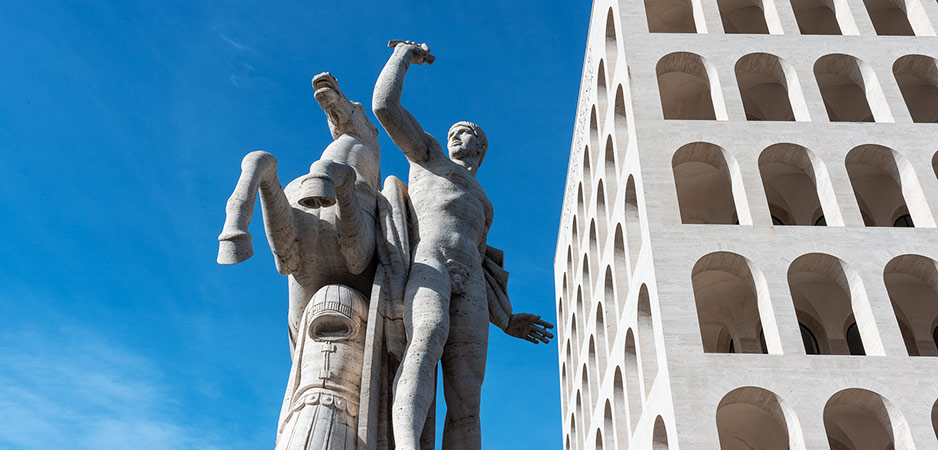During World War I, Benito Mussolini ultimately became a strong interventionist, which caused his split from Italy’s Socialist Party. He believed that only participating in a war would trigger a successful revolution at home and create the “new man.” War, however, should also establish a new realm reminiscent of the Roman Empire.
Expansionism would become a defining goal of the foreign policy of the Fascist regime. In his “Manifesto dei Fasci italiani di combattimento” (“Fascist Manifesto”), which was published in the Italian newspaper Popolo d’Italia on June 6, 1919, the future Duce briefly talked about his foreign policy plans. He argued that Italy would have to pursue a “peaceful expansion” in order to achieve its greatness — an idea that was shared by many nationalists and fascists before the March on Rome, including Paolo Pedani, the editor-in-chief of a fascist newspaper in Livorno.
Fascism and Peace: Incompatible or Inseparable?
Later in 1921, however, Mussolini struck a more aggressive note and did not mention the word “peace” once: “The foreign policy program of fascism is in one word: expansionism. Whenever the interests of humankind are at stake, Italy has to be present. It’s also time to quit living off the glories of the past. Finally, we have to live, fight, and work for the great future.” However, when we examine subsequent speeches by fascist officials, including Mussolini, they continued to address military imperialism and a quest for peace simultaneously. In many texts, we can find a striking incongruence between militarism and a discourse on peace.
But what was this “peace” Mussolini and the fascists had in mind? To understand their concept of a “peaceful” world order, we must first analyze their understanding of empire.
Pax Romana
In October 1935, Italy invaded Abyssinia and began its ruthless conquest of the East African country, prompting some historians to describe the use of poison gas and the aerial bombardment of civilians as genocidal warfare. Despite these war crimes, Mussolini stressed in his Proclamation of Empire in May 1936 the quintessence of peace: “This is an empire of peace, because Italy wants peace for itself and for all and decides to go to war only when forced by imperious, irrepressible necessities of life. Empire of civilization and humanity for all the people of Ethiopia. … In this supreme certainty, hold high, legionnaires, the signs, the steel and the hearts, to salute, after fifteen centuries, the reapportion of the Empire on Rome’s fatal hills.”
In addition, archivist and intellectual Armando Lodolini did not deny the expansionary character of Rome’s imperial drive, but he stressed that duty, energy and work were at its root. Roman soldiers, according to Lodolini, were armed engineers and farmers, who conquered Africa to present it with the gift of their civilizing influence. When the Italian army fought against the partisans in the Balkans, General Mario Robotti urged his soldiers to “be once again legionaries of civilization and of the high ideals of Rome.”
This belief in a “civilizing mission,” also known as romanità, was rooted in the 19th-century imperialist discourse and a conviction that the Italians were the heirs of the Roman Empire and the Renaissance. Therefore, violent imperialism was justified by constant references to ancient Rome, and the ultimate aim was to imitate its mission: the Pax Romana.
Jewish-Italian historian Arnaldo Momigliano, who had to flee Fascist Italy in 1938, noted that the Pax Romana “is a simple formula for propaganda, but a difficult subject for research.” It was first proclaimed in 13 BC when Emperor Augustus and his deputy Agrippa returned from pacifying the provinces. In retrospect, the term referred to a nearly 200-year period of minimal Roman conquest and relative peacefulness. During this time, the Roman Empire reached its peak territorial expansion, and its population grew up to 70 million people. Thus, the Pax Romana perfectly fit into the Fascist rhetoric: “Peace” was not secured by some form of compromise or signed agreement (a “positive peace”) but was rather established through the sheer force and power of the Roman Empire and its army.
Peace through force was exactly what the fascists were looking for at a time when they began to place Italy against the Western democracies and prepared for an imminent conflict. In 1933, a time when the regime was already considering the invasion in Ethiopia, the journalist Michele Campana argued in his book “L’impero fascista” that “fascism is … an armed people. No illusions. We have to prepare for the contrary. War is in the air in Europe. It has never been looming like in our days, after treaties have created the absurdity of a peace, that is not peace, with the desperate necessity to defend and arm itself. Then it will be good to obtain Victory, to dictate fascist peace.”
Even more explicit was Benito Mussolini after he had met with Adolf Hitler in Venice in 1934. On June 26, 1934, he stated: “We have become a strong people. Our peace is thus virile, because peace avoids weak people and accompanies strong ones.”
A Fascist Peace?
The fascists would not only limit themselves to speeches and writings to propagate their mission to reestablish the ancient Pax Romana. Art, architecture and iconography played a key role in this propagandistic “revival.” After the successful end of the Abyssinian campaign, Mussolini ordered architect Vittorio Ballio Morpurgo to construct an enclosure for the restored Ara Pacis in February 1937. This altar, today a famous Roman tourist attraction, was originally built after Augustus’ announcement of the Pax Romana in 13 BC.
On September 28, 1938, the restored Ara Pacis was inaugurated. An official newsreel by Italian state broadcaster LUCE shows the arrival of Mussolini and other fascist officials for the rededication of the Ara Pacis in its new pavilion. The event was part of the closing ceremony of the Augustan Year, the 2000-year anniversary of the emperor’s birth. Mussolini used these celebrations to cultivate a close connection with the personage of Augustus and claimed his actions were aimed at furthering the continuity of the Roman Empire.
Next to the ruins of the mausoleum of Augustus near the river Tiber, the restored altar symbolized a key element of fascist propaganda. The concomitant effect was meant to encourage the viewer in Italy and abroad to associate Mussolini’s accomplishments with Augustus’ deeds in general and the Pax Romana in particular. After signing the Easter Agreement with Great Britain in April 1938, Il Duce inspected the construction site. The Times was quick to point out this visit as another sign of Mussolini’s peaceful intentions toward London: “Signor Mussolini, who has a strong sense of the value of a symbolic act, has had the wit to make use of the significance of the monument for the present occasion by associating its reconstruction with the latest act of his foreign policy.”
Fascist Italy rejected all doctrines that postulated a form of a positive peace. Equally foreign to the spirit of fascism were all international organizations such as the League of Nations, which, according to fascists, must crumble whenever the heart of a nation is deeply stirred by idealistic or practical considerations. On the contrary, fascists celebrated a life dedicated to self-sacrifice, struggle, violence and war.
When World War II broke out and Italy did not immediately join, Mussolini was deeply troubled by this dilemma: “The Italians,” he lamented in October 1939, “after having heard my warlike propaganda for eighteen years, cannot understand how I can become the herald of peace, now that Europe is in flames.” However, it would be misleading to reduce fascism to a mere anti-peace or anti-pacifist movement. The fascists believed in a form of “negative peace,” where war is absent because of the strength of Fascist Italy. The peace order they wanted to establish, and which would allow them to carry out their social engineering and Italianization projects, mirrored the Pax Romana of old.
This concept allowed the fascists to address two seemingly contradictory but essential parts of their own propaganda. On the one hand was the formation of the fascist “new man” who was always prepared to fight should the need arise, always vigilant and on guard, and immune to the deceptions of treacherous bourgeois nations who preached peace only to remain in power. On the other hand, by constantly referring to the Pax Romana, the fascists invoked the Roman Empire as a justification of violent expansionism and the creation of Italian living space in the Mediterranean.
On October 28, 1937, Pino Romualdi, a Fascist official in Parma who would later become one of the founding fathers of the Italian neo-fascist party Movimento Sociale Italiano after the war, expressed this desire for “true peace” as follows: “Even though he is always ready to fight, so is he in the same way longing for peace, but only the “true” peace in the Roman and human sense of the word.”
*[Fair Observer is a media partner of the Centre for Analysis of the Radical Right.]
The views expressed in this article are the author’s own and do not necessarily reflect Fair Observer’s editorial policy.
Support Fair Observer
We rely on your support for our independence, diversity and quality.
For more than 10 years, Fair Observer has been free, fair and independent. No billionaire owns us, no advertisers control us. We are a reader-supported nonprofit. Unlike many other publications, we keep our content free for readers regardless of where they live or whether they can afford to pay. We have no paywalls and no ads.
In the post-truth era of fake news, echo chambers and filter bubbles, we publish a plurality of perspectives from around the world. Anyone can publish with us, but everyone goes through a rigorous editorial process. So, you get fact-checked, well-reasoned content instead of noise.
We publish 2,500+ voices from 90+ countries. We also conduct education and training programs
on subjects ranging from digital media and journalism to writing and critical thinking. This
doesn’t come cheap. Servers, editors, trainers and web developers cost
money.
Please consider supporting us on a regular basis as a recurring donor or a
sustaining member.
Will you support FO’s journalism?
We rely on your support for our independence, diversity and quality.






